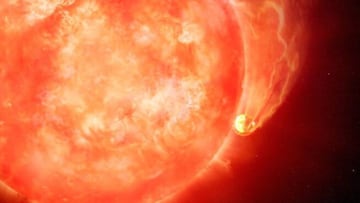A glimpse into Earth’s inevitable demise: astronomers observe a planet engulfed by its star
The evolution of a dying star’s flashes has given astronomers insight into the eventual fate of our own planet.

In a groundbreaking study published in Nature, researchers from the Massachusetts Institute of Technology (MIT), Harvard University, Caltech, and other U.S. institutions report the first-ever observation of a star consuming a planet. This extraordinary event occurred within our galaxy, approximately 12,000 light-years away, near the Aquila constellation. Astronomers noted a starburst that intensified over 100-fold within just 10 days before rapidly diminishing.
A planet disappears...
According to experts, the subsequent cooler, enduring signal following the intense white flash could only indicate the star’s absorption of a nearby planet. Kishalay De, the study’s lead author and a postdoctoral researcher at MIT’s Kavli Institute for Astrophysics and Space Research, explained, “We were looking at the final phase of the engulfment.”
In a new study, scientists at MIT, Harvard, Caltech, and elsewhere report that they have observed a star swallowing a planet for the first time. They say Earth may suffer a similar fate in 5 billion years. https://t.co/f1tFVNTyOf pic.twitter.com/YOBA5Mlv1r
— Massachusetts Institute of Technology (MIT) (@MIT) May 3, 2023
“We are seeing the future of the Earth”
The devoured planet is thought to have been a hot, Jupiter-sized world that spiraled inward and was ultimately drawn into the dying star’s atmosphere and core. Scientists believe Earth will face a similar fate, albeit not for another 5 billion years when the Sun is projected to extinguish and incinerate the solar system’s inner planets. “We are seeing the future of the Earth,” the researchers collectively cautioned.
Related stories
The team initially detected the burst in May 2020, but it took another year for astronomers to determine its cause. The initial signal emerged from data gathered by the Zwicky Transient Facility (ZTF), a Caltech-operated installation at the Palomar Observatory in California that scans the sky for rapidly fluctuating star brightness, which may indicate supernovae, gamma-ray bursts, or other phenomena.
Explanation of the initial burst
To obtain more data and pinpoint the source, De consulted observations of the same star by the Keck Observatory in Hawaii. Upon examining the amassed information, the scientists deduced that the bright, hot flash likely marked the climactic instant when a Jupiter-sized planet was enveloped by the atmosphere of an expiring star. As the planet plunged into the star’s core, the star’s outer layers were shed and formed a cold dust layer over the following year.

